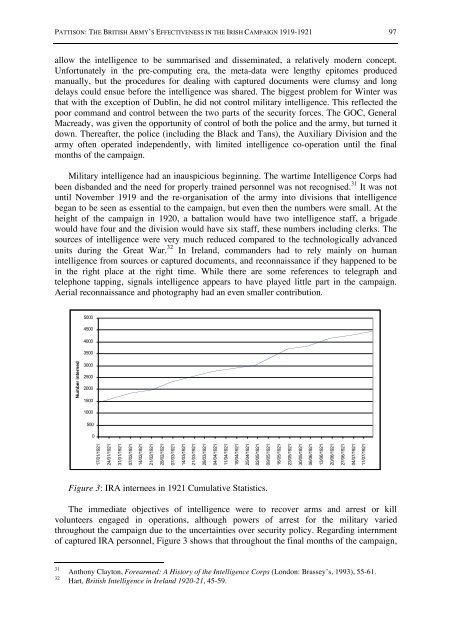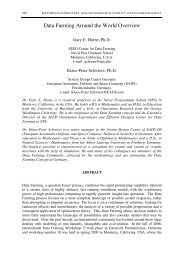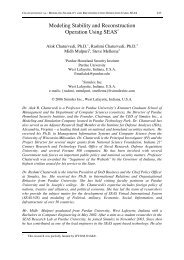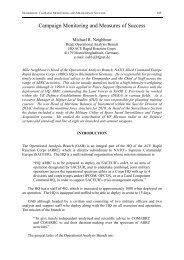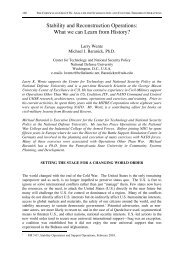The British Army's Effectiveness in the Irish ... - Cornwallis Group
The British Army's Effectiveness in the Irish ... - Cornwallis Group
The British Army's Effectiveness in the Irish ... - Cornwallis Group
You also want an ePaper? Increase the reach of your titles
YUMPU automatically turns print PDFs into web optimized ePapers that Google loves.
PATTISON: THE BRITISH ARMY’S EFFECTIVENESS IN THE IRISH CAMPAIGN 1919-1921 97<br />
allow <strong>the</strong> <strong>in</strong>telligence to be summarised and dissem<strong>in</strong>ated, a relatively modern concept.<br />
Unfortunately <strong>in</strong> <strong>the</strong> pre-comput<strong>in</strong>g era, <strong>the</strong> meta-data were lengthy epitomes produced<br />
manually, but <strong>the</strong> procedures for deal<strong>in</strong>g with captured documents were clumsy and long<br />
delays could ensue before <strong>the</strong> <strong>in</strong>telligence was shared. <strong>The</strong> biggest problem for W<strong>in</strong>ter was<br />
that with <strong>the</strong> exception of Dubl<strong>in</strong>, he did not control military <strong>in</strong>telligence. This reflected <strong>the</strong><br />
poor command and control between <strong>the</strong> two parts of <strong>the</strong> security forces. <strong>The</strong> GOC, General<br />
Macready, was given <strong>the</strong> opportunity of control of both <strong>the</strong> police and <strong>the</strong> army, but turned it<br />
down. <strong>The</strong>reafter, <strong>the</strong> police (<strong>in</strong>clud<strong>in</strong>g <strong>the</strong> Black and Tans), <strong>the</strong> Auxiliary Division and <strong>the</strong><br />
army often operated <strong>in</strong>dependently, with limited <strong>in</strong>telligence co-operation until <strong>the</strong> f<strong>in</strong>al<br />
months of <strong>the</strong> campaign.<br />
Military <strong>in</strong>telligence had an <strong>in</strong>auspicious beg<strong>in</strong>n<strong>in</strong>g. <strong>The</strong> wartime Intelligence Corps had<br />
been disbanded and <strong>the</strong> need for properly tra<strong>in</strong>ed personnel was not recognised. 31 It was not<br />
until November 1919 and <strong>the</strong> re-organisation of <strong>the</strong> army <strong>in</strong>to divisions that <strong>in</strong>telligence<br />
began to be seen as essential to <strong>the</strong> campaign, but even <strong>the</strong>n <strong>the</strong> numbers were small. At <strong>the</strong><br />
height of <strong>the</strong> campaign <strong>in</strong> 1920, a battalion would have two <strong>in</strong>telligence staff, a brigade<br />
would have four and <strong>the</strong> division would have six staff, <strong>the</strong>se numbers <strong>in</strong>clud<strong>in</strong>g clerks. <strong>The</strong><br />
sources of <strong>in</strong>telligence were very much reduced compared to <strong>the</strong> technologically advanced<br />
units dur<strong>in</strong>g <strong>the</strong> Great War. 32 In Ireland, commanders had to rely ma<strong>in</strong>ly on human<br />
<strong>in</strong>telligence from sources or captured documents, and reconnaissance if <strong>the</strong>y happened to be<br />
<strong>in</strong> <strong>the</strong> right place at <strong>the</strong> right time. While <strong>the</strong>re are some references to telegraph and<br />
telephone tapp<strong>in</strong>g, signals <strong>in</strong>telligence appears to have played little part <strong>in</strong> <strong>the</strong> campaign.<br />
Aerial reconnaissance and photography had an even smaller contribution.<br />
Number <strong>in</strong>terned<br />
5000<br />
4500<br />
4000<br />
3500<br />
3000<br />
2500<br />
2000<br />
1500<br />
1000<br />
500<br />
0<br />
17/01/1921<br />
24/01/1921<br />
31/01/1921<br />
07/02/1921<br />
14/02/1921<br />
21/02/1921<br />
28/02/1921<br />
Figure 3: IRA <strong>in</strong>ternees <strong>in</strong> 1921 Cumulative Statistics.<br />
07/03/1921<br />
14/03/1921<br />
21/03/1921<br />
28/03/1921<br />
04/04/1921<br />
11/04/1921<br />
<strong>The</strong> immediate objectives of <strong>in</strong>telligence were to recover arms and arrest or kill<br />
volunteers engaged <strong>in</strong> operations, although powers of arrest for <strong>the</strong> military varied<br />
throughout <strong>the</strong> campaign due to <strong>the</strong> uncerta<strong>in</strong>ties over security policy. Regard<strong>in</strong>g <strong>in</strong>ternment<br />
of captured IRA personnel, Figure 3 shows that throughout <strong>the</strong> f<strong>in</strong>al months of <strong>the</strong> campaign,<br />
31 Anthony Clayton, Forearmed: A History of <strong>the</strong> Intelligence Corps (London: Brassey’s, 1993), 55-61.<br />
32 Hart, <strong>British</strong> Intelligence <strong>in</strong> Ireland 1920-21, 45-59.<br />
18/04/1921<br />
25/04/1921<br />
02/05/1921<br />
09/05/1921<br />
16/05/1921<br />
23/05/1921<br />
30/05/1921<br />
06/06/1921<br />
13/06/1921<br />
20/06/1921<br />
27/06/1921<br />
04/07/1921<br />
11/07/1921


